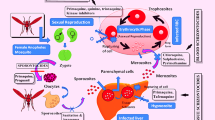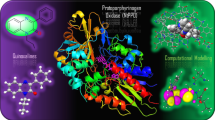Abstract
Context
Quinoxaline 1,4-di-N-oxide is a scaffold with a wide array of biological activities, particularly its use to develop new antiparasitic agents. Recently, these compounds have been described as trypanothione reductase (TR), triosephosphate isomerase (TIM), and cathepsin-L (CatL) inhibitors from Trypanosoma cruzi, Trichomonas vaginalis, and Fasciola hepatica, respectively.
Methods
Therefore, the main objective of this work was to analyze quinoxaline 1,4-di-N-oxide derivatives of two databases (ZINC15 and PubChem) and literature by molecular docking, dynamic simulation and complemented by MMPBSA, and contact analysis of molecular dynamics’ trajectory on the active site of the enzymes to know their potential effect inhibitory. Interestingly, compounds Lit_C777 and Zn_C38 show preference as potential TcTR inhibitors over HsGR, with favorable energy contributions from residues including Pro398 and Leu399 from Z-site, Glu467 from γ-Glu site, and His461, part of the catalytic triad. Compound Lit_C208 shows potential selective inhibition against TvTIM over HsTIM, with favorable energy contributions toward TvTIM catalytic dyad, but away from HsTIM catalytic dyad. Compound Lit_C388 was most stable in FhCatL with a higher calculated binding energy by MMPBSA analysis than HsCatL, though not interacting with catalytic dyad, holding favorable energy contribution from residues oriented at FhCatL catalytic dyad. Therefore, these kinds of compounds are good candidates to continue researching and confirming their activity through in vitro studies as new selective antiparasitic agents.

























Similar content being viewed by others
Data availability
The datasets generated during and/or analyzed during the current study are available in the supplementary material.
References
Méndez-Álvarez D, Herrera-Mayorga V, Juárez-Saldivar A et al (2021) Ligand-based virtual screening, molecular docking, and molecular dynamics of eugenol analogs as potential acetylcholinesterase inhibitors with biological activity against Spodoptera frugiperda. Mol Divers. https://doi.org/10.1007/S11030-021-10312-5
Juárez-Saldivar A, Schroeder M, Salentin S et al (2020) Computational drug repositioning for Chagas disease using protein-ligand interaction profiling. Int. J. Mol. Sci. 21:1–16. https://doi.org/10.3390/IJMS21124270
Ferraro F, Merlino A, Gil J, Cathepsin L et al (2019) inhibitors with activity against the liver fluke identified from a focus library of quinoxaline 1,4-di-N-oxide derivatives. Molecules. 24(2348 24):2348. https://doi.org/10.3390/MOLECULES24132348
Villalobos-Rocha JC, Sánchez-Torres L, Nogueda-Torres B et al (2014) Anti-Trypanosoma cruzi and anti-leishmanial activity by quinoxaline-7-carboxylate 1,4-di-N-oxide derivatives. Parasitol. Res. 113:2027–2035. https://doi.org/10.1007/s00436-014-3850-8
Chacón-Vargas KF, Nogueda-Torres B, Sánchez-Torres LE et al (2017) Trypanocidal activity of quinoxaline 1,4 Di-N-oxide derivatives as trypanothione reductase inhibitors. Molecules. 22:220. https://doi.org/10.3390/molecules22020220
Carta A, Loriga M, Paglietti G et al (2004) Synthesis, anti-mycobacterial, anti-trichomonas and anti-candida in vitro activities of 2-substituted-6,7-difluoro-3-methylquinoxaline 1,4-dioxides. Eur. J. Med. Chem. 39:195–203. https://doi.org/10.1016/J.EJMECH.2003.11.008
Rivera N, Rojas M, Zepeda A et al (2013) In vivo genotoxicity and cytotoxicity assessment of a novel quinoxalinone with trichomonacide activity. J. Appl. Toxicol. 33:1493–1499. https://doi.org/10.1002/JAT.2819
Estevez Y, Quiliano M, Burguete A et al (2011) Trypanocidal properties, structure–activity relationship and computational studies of quinoxaline 1,4-di-N-oxide derivatives. Exp. Parasitol. 127:745–751. https://doi.org/10.1016/j.exppara.2011.01.009
Machado-Silva A, Cerqueira PG, Grazielle-Silva V et al (2016) How Trypanosoma cruzi deals with oxidative stress: antioxidant defence and DNA repair pathways. Mutat. Res. Rev. Mutat. Res. 767:8–22. https://doi.org/10.1016/j.mrrev.2015.12.003
Palos I, Moo-Puc R, Vique-Sánchez JL et al (2021) Esters of quinoxaline-7-carboxylate-1,4-di-N-oxide as Trichomonas vaginalis triosephosphate isomerase inhibitors. Acta. Pharm. 71:485–495. https://doi.org/10.2478/ACPH-2021-0032
Benítez-Cardoza CG, Brieba LG, Arroyo R, et al (2021) Triosephosphate isomerase as a therapeutic target against trichomoniasis. Molecular and Biochemical Parasitology 246. https://doi.org/10.1016/j.molbiopara.2021.111413
Vique-Sánchez JL, Caro-Gómez LA, Brieba LG, Benítez-Cardoza CG (2020) Developing a new drug against trichomoniasis, new inhibitory compounds of the protein triosephosphate isomerase. Parasitol. Int. 76:102086. https://doi.org/10.1016/J.PARINT.2020.102086
Vázquez-Jiménez LK, Moreno-Herrera A, Juárez-Saldivar A, et al (2021) Recent advances in the development of triose phosphate isomerase inhibitors as antiprotozoal agents. Curr Med Chem 28. https://doi.org/10.2174/0929867328666210913090928
Ferraro F, Merlino A, dell´Oca N, et al (2016) Identification of chalcones as Fasciola hepatica cathepsin L inhibitors using a comprehensive experimental and computational approach. PLoS Negl Trop Dis 10. https://doi.org/10.1371/JOURNAL.PNTD.0004834
Wijffels GL, Panaccio M, Salvatore L et al (1994) The secreted cathepsin L-like proteinases of the trematode, Fasciola hepatica, contain 3-hydroxyproline residues. Biochem J 299:781. https://doi.org/10.1042/BJ2990781
Pettersen EF, Goddard TD, Huang CC et al (2004) UCSF chimera—a visualization system for exploratory research and analysis. J Comput Chem 25:1605–1612. https://doi.org/10.1002/JCC.20084
O’boyle NM, Banck M, James CA, et al (2011) Open Babel: an open chemical toolbox. https://doi.org/10.1186/1758-2946-3-33
Forli S, Huey R, Pique ME et al (2016) (2016) Computational protein–ligand docking and virtual drug screening with the AutoDock suite. Nat. Protoc. 11(5 11):905–919. https://doi.org/10.1038/nprot.2016.051
Trott O, Olson AJ (2010) AutoDock Vina: Improving the speed and accuracy of docking with a new scoring function, efficient optimization, and multithreading. J. Comput. Chem. 31:455–461. https://doi.org/10.1002/JCC.21334
Alvarez G, Martínez J, Aguirre-López B et al (2014) New chemotypes as Trypanosoma cruzi triosephosphate isomerase inhibitors: a deeper insight into the mechanism of inhibition. J. Enzyme. Inbitition. Med. Chem. 29:198–204. https://doi.org/10.3109/14756366.2013.765415
Álvarez G, Aguirre-López B, Varela J et al (2010) Massive screening yields novel and selective Trypanosoma cruzi triosephosphate isomerase dimer-interface-irreversible inhibitors with anti-trypanosomal activity. Eur. J. Med. Chem. 45:5767–5772. https://doi.org/10.1016/J.EJMECH.2010.09.034
Adasme MF, Linnemann KL, Bolz SN et al (2021) PLIP 2021: expanding the scope of the protein–ligand interaction profiler to DNA and RNA. Nucleic. Acids. Res. 49:W530–W534. https://doi.org/10.1093/NAR/GKAB294
Abraham MJ, Murtola T, Schulz R et al (2015) GROMACS: high performance molecular simulations through multi-level parallelism from laptops to supercomputers. SoftwareX 1–2:19–25. https://doi.org/10.1016/J.SOFTX.2015.06.001
Duan Y, Wu C, Chowdhury S, Lee MC, Xiong G, Zhang W, Yang R, Cieplak P, Luo R, Lee T et al (2003) A point-charge force field for molecular mechanics simulations of proteins based on condensed-phase quantum mechanical calculations. J. Comput. Chem. 24:1999–2012. https://doi.org/10.1002/jcc.10349
Wang J, Wang W, Kollman PA, Case DA (2006) Automatic atom type and bond type perception in molecular mechanical calculations. J. Mol. Graph. Model. 25:247–260. https://doi.org/10.1016/j.jmgm.2005.12.005
Wang J, Wolf RM, Caldwell JW, Kollman PA, Case DA (2004) Development and testing of a general amber force field. J. Comput. Chem. 25:1157–1174. https://doi.org/10.1002/jcc.20035
Jorgensen WL, Chandrasekhar J, Madura JD, Impey RW, Klein ML (1983) Comparison of simple potential functions for simulating liquid water. J. Chem. Phys. 79:926–935. https://doi.org/10.1063/1.445869
Bussi G, Donadio D, Parrinello M (2007) Canonical sampling through velocity rescaling. J. Chem. Phys. 126:014101. https://doi.org/10.1063/1.2408420
Berendsen HJC, Postma JPM, van Gunsteren WF, DiNola A, Haak JR (1984) Molecular dynamics with coupling to an external bath. J. Chem. Phys. 81:3684–3690. https://doi.org/10.1063/1.448118
Parrinello M, Rahman A (1981) Polymorphic transitions in single crystals: a new molecular dynamics method. J. Appl. Phys. 52:7182–7190. https://doi.org/10.1063/1.328693
Polishchuk P, Kutlushina A, Bashirova D et al (2019) Virtual screening using pharmacophore models retrieved from molecular dynamic simulations. Int J Mol Sci 20(5834 20):5834. https://doi.org/10.3390/IJMS20235834
Lemkul JA (2019) From proteins to perturbed Hamiltonians a suite of tutorials for the GROMACS-2018 Molecular Simulation Package [Article v1.0]. Living. J. Comput. Mol. Sci. 1:5068–5068. https://doi.org/10.33011/LIVECOMS.1.1.5068
Darden T, York D, Pedersen L (1993) Particle Mesh Ewald: An N ⋅log( N ) Method for Ewald sums in large systems. J. Chem. Phys. 98:10089–10092. https://doi.org/10.1063/1.464397
Hess B, Bekker H, Berendsen HJC, Fraaije JGEM (1997) LINCS: a linear constraint solver for molecular simulations. J. Comput. Chem. 18:1463–1472. https://doi.org/10.1002/(SICI)1096-987X(199709)18:12%3c1463:AID-JCC4%3e3.0.CO;2-H
Bouysset C, Fiorucci S (2021) ProLIF: a library to encode molecular interactions as fingerprints. J. Cheminform. 13:72. https://doi.org/10.1186/s13321-021-00548-6
Kumari R, Kumar R, Lynn A (2014) g_mmpbsa —a GROMACS tool for high-throughput MM-PBSA calculations. J. Chem. Inf. Model. 54:1951–1962. https://doi.org/10.1021/ci500020m
Baker NA, Sept D, Joseph S et al (2001) Electrostatics of nanosystems: application to microtubules and the ribosome. Proc. Natl. Acad. Sci. USA. 98:10037–10041. https://doi.org/10.1073/pnas.181342398
Salentin S, Haupt VJ, Daminelli S, Schroeder M (2014) Polypharmacology rescored: protein–ligand interaction profiles for remote binding site similarity assessment. Prog. Biophys. Mol. Biol. 116:174–186. https://doi.org/10.1016/j.pbiomolbio.2014.05.006
Torres E, Moreno-Viguri E, Galiano S et al (2013) Novel quinoxaline 1,4-di-N-oxide derivatives as new potential antichagasic agents. Eur. J. Med. Chem. 66:324–334. https://doi.org/10.1016/j.ejmech.2013.04.065
Chang TC, Park JH, Colquhoun AN et al (2018) Evaluating the catalytic importance of a conserved Glu97 residue in triosephosphate isomerase. Biochem. Biophys. Res. Commun. 505:492–497. https://doi.org/10.1016/J.BBRC.2018.09.076
Funding
This work was supported by Secretaria de Investigacion y Posgrado del Instituto Politecnico Nacional (Grants 20220935 and 20230935).
Author information
Authors and Affiliations
Contributions
All authors contributed to the study conception and design. Material preparation, data collection, and analysis were performed by Alonzo González-González, Domingo Méndez-Álvarez, and Lenci K. Vázquez-Jiménez, Timoteo Delgado-Maldonado, Eyra Ortiz-Pérez, Alma D. Paz-González, Debasish Bandyopadhyay, and Gildardo Rivera. The first draft of the manuscript was written by Alonzo Gonzalez-Gonzalez, and Gildardo Rivera, and all authors commented on previous versions of the manuscript. All authors read and approved the final manuscript.
Corresponding author
Ethics declarations
Competing interests
The authors declare no competing interests.
Additional information
Publisher's note
Springer Nature remains neutral with regard to jurisdictional claims in published maps and institutional affiliations.
Supplementary Information
Below is the link to the electronic supplementary material.
Rights and permissions
Springer Nature or its licensor (e.g. a society or other partner) holds exclusive rights to this article under a publishing agreement with the author(s) or other rightsholder(s); author self-archiving of the accepted manuscript version of this article is solely governed by the terms of such publishing agreement and applicable law.
About this article
Cite this article
González-González, A., Méndez-Álvarez, D., Vázquez-Jiménez, L.K. et al. Molecular docking and dynamic simulations of quinoxaline 1,4-di-N-oxide as inhibitors for targets from Trypanosoma cruzi, Trichomonas vaginalis, and Fasciola hepatica. J Mol Model 29, 180 (2023). https://doi.org/10.1007/s00894-023-05579-4
Received:
Accepted:
Published:
DOI: https://doi.org/10.1007/s00894-023-05579-4




